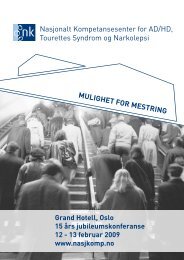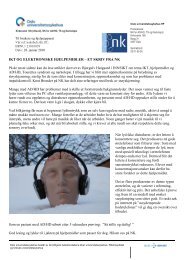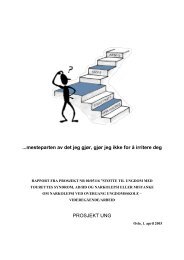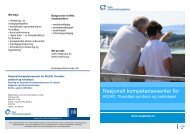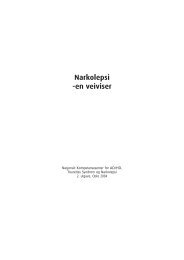denne lenken - Nasjonalt Kompetansesenter for AD/HD, Tourettes ...
denne lenken - Nasjonalt Kompetansesenter for AD/HD, Tourettes ...
denne lenken - Nasjonalt Kompetansesenter for AD/HD, Tourettes ...
Create successful ePaper yourself
Turn your PDF publications into a flip-book with our unique Google optimized e-Paper software.
Mandag 08.03.2010<br />
Sesjon 1<br />
Aase, Heidi: Neuropsychological functions and symptoms of <strong>AD</strong><strong>HD</strong> in preschool children –<br />
preliminary findings<br />
Background: Attention-Deficit/Hyperactivity Disorder (<strong>AD</strong><strong>HD</strong>) is considered to be a<br />
neurodevelopmental disorder characterized by age-inappropriate levels of inattention, hyperactivity and<br />
impulsiveness. Diagnostic criteria are, however, only valid <strong>for</strong> age 6 and older. Population-based<br />
prospective studies are in demand to identify early signs of deviant development and early developmental<br />
trajectories that will contribute to our understanding of the underlying mechanisms and etiological factors<br />
involved in this debilitating disorder.<br />
The Norwegian Mother and Child Cohort Study (MoBa) is a population-based prospective birth cohort<br />
study. By the end of enrolment in December 2008, 107.000 pregnancies had been included. The MoBa<br />
study follows the mother through pregnancy, and mother and child after birth with questionnaires at ages<br />
6, 18, and 36 months. New questionnaires are on the way when the child is 5, 7 and 8 years old. In<br />
addition, blood samples are collected from mother and father during early pregnancy (18 weeks) and from<br />
mother and child (cord) at birth. Urine samples are collected from mother in early pregnancy. The MoBa<br />
represents a unique opportunity to investigate key questions about etiological and developmental issues<br />
related to <strong>AD</strong><strong>HD</strong>.<br />
The <strong>AD</strong><strong>HD</strong> study is a research collaboration between the Norwegian Institute of Public Health and Oslo<br />
University Hospital, Ullevål, and a substudy to the MoBa study.<br />
Objectives: The main aim of the study is threefold: 1) to describe the spectrum and characteristics of<br />
inattentive and restless behaviour (including associated problems) in preschool age; 2) to analyze<br />
developmental trajectories of symptom patterns related to <strong>AD</strong><strong>HD</strong>, and 3) to identify important etiological<br />
factors <strong>for</strong> inattentive, restless, and impulsive behaviours and their comorbidities.<br />
Methods: The study has a prospective design including a case-control group design. From the MoBa<br />
cohort a total of 1200 children aged 36-44 months are selected based on scores on screening questions<br />
assessing restlessness, impulsiveness, and attention problems in the 36-month questionnaire. A group of<br />
400 children are randomly selected <strong>for</strong> a control group. Both groups undergo a one-day clinical<br />
examination, including neuropsychological, neuromotor, and child psychiatric assessment. A structured<br />
clinical interview with one parent and a structured parent-child interaction task is also included.<br />
Preliminary results: Preliminary results from a sub-sample of the clinically assessed participants indicate<br />
that <strong>AD</strong><strong>HD</strong> screening questions at age 3 years are sensitive to mental health problems, but not specific to<br />
<strong>AD</strong><strong>HD</strong>. Preliminary data indicate that about 25 prosent of children have <strong>AD</strong><strong>HD</strong> symptoms within clinical<br />
range and about 37 prosent have significant symptoms associated with other disorders. Almost all children<br />
with significant symptoms of <strong>AD</strong><strong>HD</strong> score above cut-off on screening questions. Most children with<br />
<strong>AD</strong><strong>HD</strong> symptoms have symptoms of other conditions (~80 prosent). Children with significant <strong>AD</strong><strong>HD</strong><br />
symptoms score lower than the normal group on all neuropsychological measures, and deviates also from<br />
a group of children with other clinical symptoms on most measures.<br />
Helland, Wenche Andesen: Communication impairments in children with <strong>AD</strong><strong>HD</strong><br />
Fleire studiar har dei seinare åra rapportert om språkvanskar hos barn med <strong>AD</strong>/<strong>HD</strong> (Bignell &<br />
Chain, 2007; Bruce, Ternlund, & Nettelbladt, 2006; Im-Bolter & Cohen, 2007). Men sjølv om<br />
språkvanskar førekjem relativt ofte blant desse barna er dei ikkje mellom dei diagnostiske kriteriane <strong>for</strong><br />
<strong>AD</strong>/<strong>HD</strong>. Kommunikasjonsvanskar kan oppstå som følge av problem med språkleg innhald, <strong>for</strong>m eller<br />
bruk. I <strong>for</strong>skingssamanhang har ein i stor grad fokusert på innhaldsida og <strong>for</strong>msida av språket, medan ein<br />
har vore mindre oppteken av språket i bruk eller pragmatikk. Ein mogeleg grunn til dette kan vera<br />
mangelen på eigna kartleggingsinstrument.<br />
Side 2 av 14



